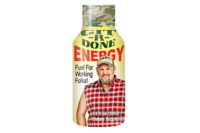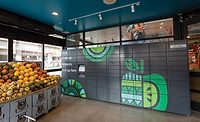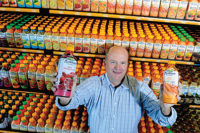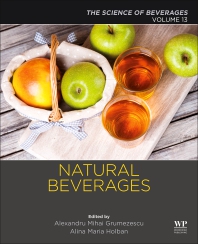The Natural Revolution Continues
2008 NEW PRODUCT DEVELOPMENT SURVEY
The Natural Revolution Continues
It should come as no surprise, but Beverage Industry’s 2008 New Product Development Survey confirms that natural ingredients will continue to lead flavor and color usage in 2008. Nearly three-quarters of the flavors purchased this year will be natural flavors, and 70 percent of the colors used in beverages will be natural colors, according to respondents.
Consumer preference for natural products was cited as
the No. 1 reason beverage companies are choosing those ingredients,
followed by marketplace trends and health concerns. One respondent pointed
to the success of Cadbury’s 7 UP formulation change as a reason to
use more natural ingredients in the coming year, while others said natural
ingredients make for a “better ingredient label” and
“better taste in the end result.” Demands from retailers also
are causing beverage companies to evaluate their ingredient labels —
one respondent indicated a push into the natural foods channel required
natural ingredients, while another said, “more restaurants are
looking at going natural or organic.”
Natural or not, flavors ranked as the top ingredient
purchase in 2007. The effort to keep on top of
the health and wellness trend led beverage companies to rank vitamins and
minerals as their second “most-purchased” ingredients last
year, after flavors. Citric acid and juice concentrates also were top
getters, as was caffeine — an indication of the continuing energy
trend. Forty-three percent of respondents said they used caffeine last
year, which is a slight increase over the 39 percent who used it in 2006.
Thirty-four percent added “other energy producing ingredients”
as well, up from 27 percent in 2006.
Sugar ranked ahead of corn sweeteners, with 41 percent
saying they purchased sugar last year vs. 33 percent who used high fructose
corn syrup. Respondents were allowed multiple responses, however, and could
have purchased both. When it came to low-calorie sweeteners, slightly more
survey respondents said they used sucralose (29 percent) last year than
aspartame (27 percent). Twenty-two percent used acesulfame potassium and 5
percent incorporated stevia into their drinks.
Antioxidants were used by 34 percent of respondents
last year, compared with 24 percent who said they used them in their
products in 2006. On the other hand, the use of botanicals and herbs fell
slightly, from 20 percent who said they used those ingredients in 2006, to
17 percent in 2007.
Budget concerns
Overall, beverage companies expect to spend about the
same amount on research and development this year as they did last year.
More than 70 percent of survey respondents said their R&D budgets would
stay on par with 2007, while 26 percent said they expect their budgets to
increase. Of those who expect to spend more this year, almost 30 percent of
coffee and tea companies say their R&D budgets will get a cash
infusion, and 46 percent of respondents at spirits companies say they will
have more money to spend in 2008. On the flip side, a small percentage of
coffee and tea companies — about 7 percent — and an equal
percentage of soft drink companies, say they will have less money at their
disposal in the coming year.
The largest percentage of respondents put their
product development costs in the $50,000 to $250,000 range. According to
the survey, wine, coffee and tea products are the most expensive products
to launch from inception to shelf, possibly due to their unpredictable
agricultural nature. Soft drinks cost an average of $306,000 to bring to
market, beer runs an average of $204,000 and energy drinks about $101,000.
Across all beverage categories, respondents indicated
their companies developed an average of 25 drinks last year, although not
all of those products actually were released to market. The largest
percentage of companies fell in the range of five to 10 products.
Spirits companies had the busiest product development
departments, creating an average of 60 products in 2007. Soft drink-makers
developed an average 47 products last year, coffee and tea companies
created an average 25 new products, and beer companies brewed up 15 new
products. In the coming year, energy drink-makers plan to step up their
activities, with a little more than half saying they will develop more new
products this year than last, while 47 percent of bottled water companies
and 41 percent of soft drink companies plan to develop more beverages in
2008.
On average, slightly more than half of respondents say
they plan to maintain the same product development pace in 2008.
Thirty-four percent say they have more new products on the docket for the
coming year, and 14 percent said they believe their companies will develop
fewer new releases this year.
When it comes to releasing those products to market,
coffee and tea companies led the pack last year, with an average 20
rollouts. Soft drink-makers followed with almost 18 products each, and
spirits companies introduced an average of 9 new products to market in
2007.
Less than half — 44 percent — of new
product releases last year were considered successful, at least by their
own companies’ definitions. The largest percentage of respondents put
their success rates between 1 and 25 percent.
| Ingredients used in 2007 | |
| Ingredient | % of respondents* |
| Flavors | 54% |
| Vitamins, minerals, iron, colloids, etc. | 46% |
| Citric acid | 45% |
| Juice/concentrate | 44% |
| Caffeine | 43% |
| Sugar | 41% |
| Colors | 36% |
| Other energy-producing ingredients | 34% |
| High fructose corn syrup | 33% |
| Caramel color | 29% |
| Sucralose | 29% |
| Aspartame | 27% |
| Coffee | 25% |
| Acesulfame potassium | 22% |
| Other sweeteners/blends | 22% |
| Cocoa/chocolate | 23% |
| Organics | 23% |
| Botanicals (herbs/spices) | 18% |
| Dairy/dairy products | 18% |
| Malts, hops, yeast, extracts | 18% |
| Stabilizers | 18% |
| Acidulants | 16% |
| Gums | 15% |
| Emulsifiers | 14% |
| Anti-foaming agents | 13% |
| Essential oils | 12% |
| Soy | 8% |
| Starches | 8% |
| Stevia | 5% |
| Anti-caking agents | 4% |
Alcohol releases seem to fare best at launch, according to respondents. Wine-makers indicate an average 70 percent success rate, while distilled spirits companies say 56 percent of their products achieved expectations in 2007. Bottled water, dairy-based drinks and juice drinks follow the alcohol brands, with an average 52 percent, 51 percent and 49 percent, respectively, meeting their companies’ standards of success last year. Soft drinks were the least likely to be considered successful by their developers — slightly less than 32 percent were thought to be success stories in their launch year.
When product introductions were less than stellar, a
lack of marketing, poor execution, distribution and market research issues
were often cited as the reasons. Pricing also has been an issue, both on
the consumer side and the product development side, with one respondent
saying an unsuccessful product was “priced too high,” and
another indicating the ingredients were too expensive.
A matter of timing
The race to get products to market also weighs
heavily on success — wait too long and you miss your opportunity, as
one respondent indicated, saying the “market was flooded with similar
products by the time of release.” Another said their company was
“too slow to market.”
On the other hand, if you’re ahead of your
time, consumers might not warm up to the concept right away. One respondent
said their product was “too early for consumer tastes.” Singing
a more optimistic tune, another respondent said, “People take a while
to adventure into a new taste,” but added, “once they [find]
it, they never go back!”
 |
 |
 |
 |
Half of respondents across all beverage categories indicated it takes anywhere from four to nine months to develop a new product from concept to consumer. Fourteen percent can turn out a new drink in three months or less, while 8 percent require more than 18 months to put the finishing touches on a new concept. About a quarter of respondents said they were able to speed their time to market in 2007 vs. 2006, but the vast majority said their development work took the same amount of time as the previous year.
Of those who improved their development time, one
said their company “aligned the organization to a common development
process.” Another cited “better research on the front
end,” and one respondent said they developed “more in-house
flavor systems.” A number of respondents credited their ingredient
suppliers with speeding the development process along. One said
“supplier cooperation” aided in speed to market, while another
said the company “worked closer with the flavor house” in 2007.
Most respondents, however — 72 percent across
all beverage categories — said their ideas for new products are
generated in-house as opposed to supplier involvement. According to the 28
percent that do make use of their supplier connections to generate ideas,
ingredient companies suggest new flavor options or combinations, provide
advice for how to execute existing ideas, and “send samples of
promising new products.” One respondent praised supplier partners,
saying they assisted by “sharing their historical knowledge. This
industry is so big that no one has all [the] information —
interacting with others is essential.”
The effort to bring new products to market is largely
led by beverage companies’ attempts to keep up with consumer trends,
according to survey respondents. Staying ahead of the competition,
increasing market share and satisfying retail and distributor customers
also were cited by many.
“[The] beverage industry is always evolving so
a company must do the same to stay ahead of the game,” commented one
survey taker. “Identify what the consumer wants before the demand
exists,” is a goal that keeps one respondent in the R&D lab.
“Excitement produces wealth,” added another, who sees the
benefits of keeping consumers on their toes.
New ethnic groups were top of mind with one survey
taker who said “new groups and [the] flavor trends they bring into
the USA” was a motivational factor.
Some are motivated by rather lofty goals. Several
respondents cited health issues as a reason for creating new products, and
one indicated a desire to create “a drink that makes a
difference.” Another said, “All the artificially colored and
flavored beverages, containing other artificial ingredients and
preservatives, and containing high fructose corn syrup and caffeine, all
this motivates me.” Still another said the goal is “to be in
the top 100 innovative companies in the world.”
Team players
The vast majority of survey respondents — 85
percent — say they take a team approach to new product development.
Sales and marketing representatives are part of 79 percent of product
development teams, making them the group with the most influence on new
products. Upper management is present on 62 percent of development teams,
while production is involved in 54 percent and R&D personnel in 53
percent. Retail and distributor customers voice their opinions and concerns
on 47 percent of product development teams, while packaging designers play
a part in 44 percent and a nutritionist weighs in on a third of all teams.
An average new product development department in the
beverage industry involves 37 people, according to survey results.
Companies are nearly equally split in their decision to outsource R&D
work, with 47 indicating they look to outside resources for help, and 53
percent saying they keep things in-house.
Beverage industry chief executive officers play a
role in product development 80 percent of the time, according to survey
respondents. He or she provides leadership and is an ultimate
decision-maker in nearly half of the cases, while 30 percent of respondents
say their chief executive officer stands back a bit, but provides guidance
and advice. Among responding companies, the chief executive officer has
some tenure in the product development process, with the average CEO adding
12 years of experience to the process.
Beverage companies say they get most of their ideas
from consumers. Nearly two-thirds of survey takers said consumer trends are
the No. 1 source of new drink concepts. Upper management, research and
testing, retail and distributor customers, and the marketing department
also are strong influences, with about 50 percent of respondents naming
each of those groups as sources of new ideas (respondents were allowed
multiple responses).
When respondents were asked for a wish list of
equipment, ingredients, packaging innovations, marketing tools or other
developments that would help in the product development process, the
suggestions ranged from simply having more time and money to high-tech
mechanical innovations.
One brewer suggested “a small, easily used pilot
brewing system, 5 gallons or so,” and another respondent suggested
“a machine that can gather ingredients and mix a small scale lab
formula in minutes, so multiple samples could be made with minute changes
in them and then compared.” An additional high-tech innovation that
would be helpful included “a taste and smell computer like they are
developing for law enforcement dog replacement,” and one respondent
had the environment in mind with the suggestion for more energy-efficient
equipment.
Packaging innovations, however, were the top
vote-getter. “Lower-priced plastic containers,” was one
respondent’s wish, while “locally produced wine bottles,”
would help out another. “New packaging innovations” were cited
by another survey taker, as were a “replacement for glass
bottles,” and “sources for packaging elements.” And one
respondent indicated the need for “an affordable, customer-friendly
package ... or a big investor.”
Methodology... Beverage
Industry’s New Product Development Survey
was conducted by BNP Market Research. The online survey was conducted in
November 2007, and included a systematic random sample of beverage
companies based on Beverage Industry’s domestic circulation base.
Thirty-seven percent of respondents were from larger
beverage companies — those earning more than $100 million in annual
sales revenue. Twenty-two percent fell in the mid-size company range
— $10 million to $100 million. Forty-one percent were from smaller
companies — those with less than $10 million in annual revenue.
On a regional basis, the Northeast, Midwest, Southern
and Western United States were represented in nearly equal percentages.
Thirty-six percent of respondents indicated they also do business in
Canada, 25 percent in Europe, 24 percent in Asia or the Middle East, 21
percent in South and Central America, 15 percent in the Australasia region
and 12 percent in Africa.
Looking for a reprint of this article?
From high-res PDFs to custom plaques, order your copy today!






